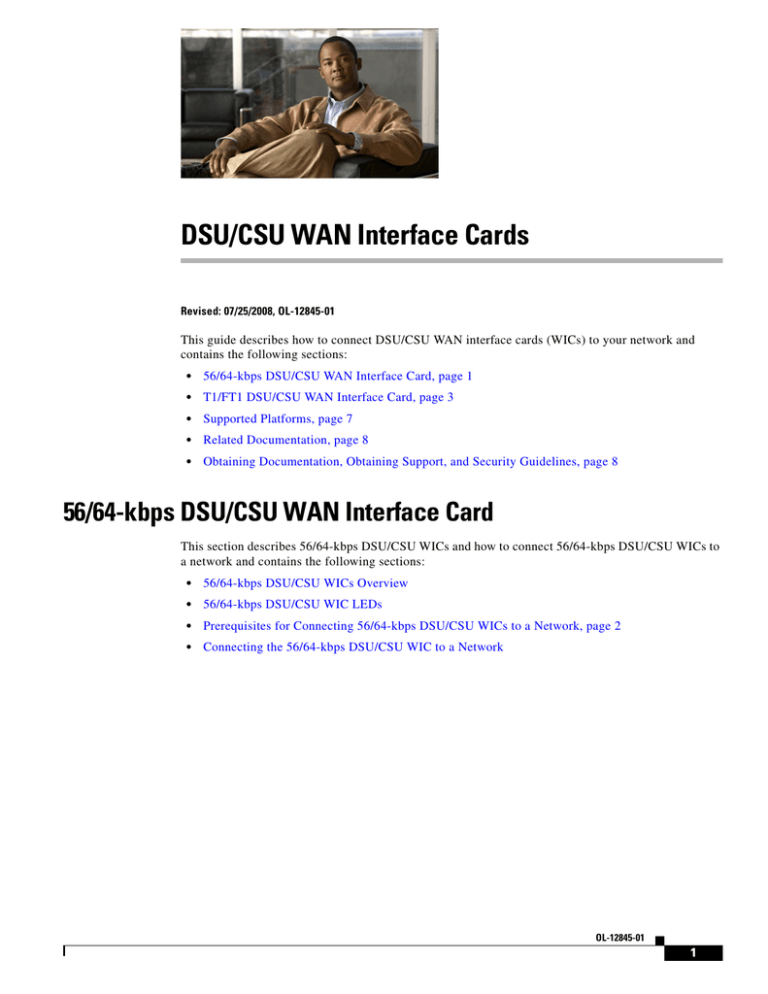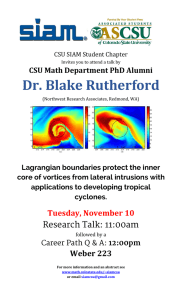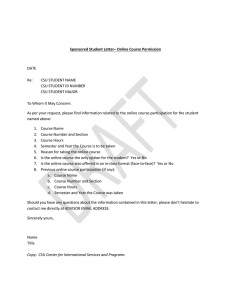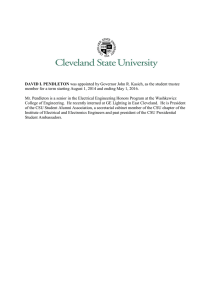
DSU/CSU WAN Interface Cards
Revised: 07/25/2008, OL-12845-01
This guide describes how to connect DSU/CSU WAN interface cards (WICs) to your network and
contains the following sections:
•
56/64-kbps DSU/CSU WAN Interface Card, page 1
•
T1/FT1 DSU/CSU WAN Interface Card, page 3
•
Supported Platforms, page 7
•
Related Documentation, page 8
•
Obtaining Documentation, Obtaining Support, and Security Guidelines, page 8
56/64-kbps DSU/CSU WAN Interface Card
This section describes 56/64-kbps DSU/CSU WICs and how to connect 56/64-kbps DSU/CSU WICs to
a network and contains the following sections:
•
56/64-kbps DSU/CSU WICs Overview
•
56/64-kbps DSU/CSU WIC LEDs
•
Prerequisites for Connecting 56/64-kbps DSU/CSU WICs to a Network, page 2
•
Connecting the 56/64-kbps DSU/CSU WIC to a Network
OL-12845-01
1
DSU/CSU WAN Interface Cards
56/64-kbps DSU/CSU WAN Interface Card
56/64-kbps DSU/CSU WICs Overview
The 1-port 56/64-kbps DSU/CSU WIC (WIC-1DSU-56K4) includes an integral DSU/CSU and can be
configured to provide circuit-switched, dedicated, or leased-line service at 56 kbps. This WIC also
supports 64-kbps dedicated lines. (See Figure 1.)
Figure 1
WIC-1DSU-56K4 Front Panel
56- or 64-kbps port
DSU
56K
SEE MANUAL BEFORE INSTALLATION
41224
CD
LED
AL
LP
RD
TD
LEDs
56/64-kbps DSU/CSU WIC LEDs
The 56/64-kbps DSU/CSU WIC LEDs, are shown in Figure 1. The functions of the LEDs are described
in Table 1.
Table 1
56/64-kbps DSU/CSU WIC LEDs
LED
Description
TD
Data is being transmitted to the DTE interface.
RD
Data is being received from the DTE interface.
LP
Internal DSU/CSU is in loopback mode.
AL
One of these alarm conditions is present: no receive signal, loss of frame signal from
the remote station, or out of service signal from the remote station. This LED is off
during normal operation.
CD
Internal DSU/CSU in the WIC is communicating with another DSU/CSU.
Prerequisites for Connecting 56/64-kbps DSU/CSU WICs to a Network
Before connecting a WIC to the network, ensure that the WIC is installed in the router, the equipment is
properly grounded, and you have the proper cables for connecting the WIC to the network. This section
describes the preparation necessary before connecting a 56/64-kbps DSU/CSU WIC to the network.
Installing a Cisco Serial WAN Interface Card
Install the serial WIC according to the instructions in Installing Cisco Interface Cards in Cisco Access
Routers.
Grounding
Ensure that the equipment you are working with is properly grounded. For instructions on grounding
your serial WIC, see Installing Cisco Interface Cards in Cisco Access Routers.
OL-12845-01
2
DSU/CSU WAN Interface Cards
T1/FT1 DSU/CSU WAN Interface Card
Cables
Use a straight-through RJ-48S-to-RJ-48S cable (not included) to connect a 56/64-kbps DSU/CSU WIC
to a network.
Connecting the 56/64-kbps DSU/CSU WIC to a Network
To connect a 56/64-kbps DSU/CSU WIC to a network, follow these steps:
Step 1
Confirm that the router is turned off.
Step 2
Connect one end of the straight-through RJ-48S-to-RJ-48S cable to the RJ-48S port on the 56/64-kbps
DSU/CSU WIC.
Step 3
Connect the other end of the cable to the 56/64-kbps services wall jack, as shown in Figure 2.
Figure 2
Connecting the 56/64-kbps DSU/CSU WIC to a 56/64-kbps Services Wall Jack
CD
LP
AL
TD
RD
Switched 56/64-kbps port
(RJ-48S)
DSU
56K
SEE MANUAL BEFORE INSTALLA
TION
43737
Straight-through
RJ-48S-to-RJ-48S cable
RJ-48S jack
Step 4
Turn on power to the router.
Step 5
Check that the CD LED comes on, which indicates that the internal DSU/CSU is communicating with
the DSU/CSU at the 56/64-kbps service provider’s central office.
T1/FT1 DSU/CSU WAN Interface Card
This section describes how to connect T1/fractionalized T1 (FT1) DSU/CSU WICs to the network and
contains the following sections:
•
T1/FT1 DSU/CSU WICs Overview
•
T1/FT1 DSU/CSU WIC LEDs and Loopback Button
•
Enabling Wetting Current on T1/FT1 DSU/CSU WICs
•
Prerequisites for Connecting a T1/FT1 DSU/CSU WIC to a Network
•
Connecting a T1/FT1 DSU/CSU WIC to a Network
OL-12845-01
3
DSU/CSU WAN Interface Cards
T1/FT1 DSU/CSU WAN Interface Card
T1/FT1 DSU/CSU WICs Overview
The 1-port T1/fractionalized T1 (FT1) DSU/CSU WIC includes an integrated data service unit/channel
service unit (DSU/CSU). The WIC can be configured for either full T1 services or fractionalized T1
services. There are two T1/FT1 DSU/CSU WICs:
Caution
•
1-port T1/fractionalized T1 (FT1) DSU/CSU WIC (WIC-1DSU-T1) (see Figure 3)
•
1-port T1/fractionalized T1 (FT1) DSU/CSU WIC, version 2 (WIC-1DSU-T1-V2) (see Figure 4)
To comply with the Telcordia GR-1089 NEBS standard for electromagnetic compatibility and safety,
connect the 1-port T1/FT1 DSU/CSU WIC, version 2 (WIC-1DSU-T1-V2) only to intra-building or
non-exposed wiring or cabling. The intrabuilding cable must be shielded and the shield must be
grounded at both ends.
Figure 3
WIC-1DSU-T1 Front Panel
T1 port
LP
AL
CD
Loopback
button
CD
LP
DSU
CSU
T1
T1 DSU/CSU
41215
LOOP
BACK
SEE MANUAL
BEFORE
INSTALLATION
AL
Figure 4
WIC-1DSU-T1-V2 Front Panel
T1 port
LP
AL
CD
T1 DSU/CSU
Loopback
button
CD
LP
WIC
1DSU-T1
V2
88109
LOOP
BACK
SEE MANUAL
BEFORE
INSTALLATION
AL
T1/FT1 DSU/CSU WIC LEDs and Loopback Button
The T1/FT1 DSU/CSU WIC LEDs and loopback button are shown in Figure 3 and Figure 4. The
functions of the LEDs and loopback button are described in Table 2.
Table 2
Feature
Color
Description
LP LED
Yellow
Line or loopback state is detected or is manually set by the user.
Off
Normal operation.
OL-12845-01
4
T1/FT1 DSU/CSU WIC LEDs and Loopback Button
DSU/CSU WAN Interface Cards
T1/FT1 DSU/CSU WAN Interface Card
Table 2
T1/FT1 DSU/CSU WIC LEDs and Loopback Button (continued)
Feature
Color
Description
AL LED
Yellow
Remote station has an alarm condition.
Off
Normal operation.
CD LED
Green
Internal DSU/CSU in the WIC is communicating with another
DSU/CSU. This LED is on during normal operation.
Loopback
button
—
Push this button to place the WIC into loopback mode. The service
provider can send a signal to test the connection from your site to
the central office switch.
Push this button again to turn off loopback mode.
Enabling Wetting Current on T1/FT1 DSU/CSU WICs
The WIC-1DSU-T1-V2 interface card supports wetting current. Wetting current is a small amount of
electrical current (60 to 140 milliamps) sent from the central office to the card to prevent the corrosion
of electrical contacts in the card’s network connection.
Wetting current may be enabled or disabled by the user. It is controlled by the placement of a jumper on
connector J2 on the card. Figure 5 shows the J2 connector and the jumper.
The feature is enabled by connecting pins 1 and 2 of the J2 connector with a jumper. It is disabled either
by removing the jumper or by connecting pins 2 and 3 of the J2 connector.
The card is shipped with the jumper connecting pins 2 and 3 on the J2 connector, which disables the
wetting current.
Figure 5
Jumper Settings for Controlling Wetting Current on the WIC-1DSU-T1 V2 Card
J2
Wetting current
enabled
J2
Wetting current
disabled
Wetting current
jumper
88130
J2
OL-12845-01
5
DSU/CSU WAN Interface Cards
T1/FT1 DSU/CSU WAN Interface Card
Prerequisites for Connecting a T1/FT1 DSU/CSU WIC to a Network
Before connecting a WIC to the network, ensure that the WIC is installed in the router, the equipment is
properly grounded, and you have the proper cables for connecting the WIC to the network. This section
describes the preparation necessary before connecting a T1/FT1 DSU/CSU WIC to the network.
Installing a Cisco Serial WAN Interface Card
Install the Cisco serial WIC according to the instructions in Installing Cisco Interface Cards in Cisco
Access Routers.
Grounding
Ensure that the equipment you are working with is properly grounded. For instructions on grounding
your serial WIC, see Installing Cisco Interface Cards in Cisco Access Routers.
Cables
Use a straight-through RJ-48C-to-RJ-48C cable to connect a T1/FT1 DSU/CSU WIC to a network.
Connecting a T1/FT1 DSU/CSU WIC to a Network
To connect a T1/FT1 DSU/CSU WIC to a network, follow these steps:
Step 1
Caution
Confirm that the router is turned off.
To comply with the Telcordia GR-1089 NEBS standard for electromagnetic compatibility and safety,
connect the 1-port T1/FT1 DSU/CSU WIC, version 2 (WIC-1DSU-T1-V2) only to intra-building or
non-exposed wiring or cabling. The intrabuilding cable must be shielded and the shield must be
grounded at both ends.
Step 2
Connect one end of the straight-through RJ-48C-to-RJ-48C cable to the RJ-48C port on the T1/FT1
DSU/CSU WIC.
Step 3
Connect the other end of the cable to the T1 wall jack, as shown in Figure 6.
OL-12845-01
6
DSU/CSU WAN Interface Cards
Supported Platforms
Figure 6
Connecting the T1/FT1 DSU/CSU WIC to a T1 Wall Jack
T1 port
(RJ-48C)
LOOP
BACK
SEE MANUAL
BEFORE
INSTALLATION
LP
AL
CD
T1 DSU/CSU
DSU
CSU
T1
41196
Straight-through
RJ-48C-to-RJ-48C cable
T1 (RJ-48C)
wall jack
Step 4
Turn on power to the router.
Step 5
Check that the CD LED comes on, which means that the internal DSU/CSU is communicating with the
DSU/CSU at the T1 service provider’s central office.
Supported Platforms
For a list of the platforms supported by a Cisco interface card see Platform Support for Cisco Interface
Cards.
Finding Support Information for Platforms and Cisco IOS Software Images
Use Cisco Feature Navigator to find information about platform support and Cisco IOS software image
support. Access Cisco Feature Navigator at http://www.cisco.com/go/fn. You must have an account on
Cisco.com. If you do not have an account or have forgotten your username or password, click Cancel at
the login dialog box and follow the instructions that appear.
OL-12845-01
7
DSU/CSU WAN Interface Cards
Related Documentation
Related Documentation
For additional information, see the following documents and resources.
Related Topic
Document Title
1-port 4-wire 56/64 kpbs CSU/DSU WIC
tech note
Understanding the 1-Port 4-Wire 56/64 Kpbs CSU/DSU WAN Interface Card
(WIC-1DSU-56K4)
http://www.cisco.com/en/US/products/hw/modules/ps3129/products_tech_not
e09186a00800a99cc.shtml
Integrated DSU/CSU modules and WICs
tech note
Configuring Cisco Integrated Data Service Unit/Channel Service Unit
(DSU/CSU) Modules and WAN Interface Cards
http://www.cisco.com/en/US/products/hw/routers/ps233/products_tech_note09
186a0080093c56.shtml
56K CSU support for Cisco Signaling Link 56K CSU Support for the Cisco Signaling Link Terminal
Terminal feature module
http://www.cisco.com/en/US/docs/ios/12_2t/12_2t2/feature/guide/ftsltwic.htm
l
Cisco Signaling Link Terminal feature
module
Cisco Signaling Link Terminal
http://www.cisco.com/en/US/docs/ios/12_1t/12_1t1/feature/guide/dt_slt.html
1-port DSU/CSU T1 WIC feature module
1-Port DSU/CSU T1 WIC for the Cisco 1700, Cisco 2600, Cisco 3600, and
Cisco 3700 Series Routers
http://www.cisco.com/en/US/docs/ios/12_2/12_2z/12_2zl/feature/guide/t1dsu.
html
Regulatory compliance and safety
information
Cisco Network Modules and Interface Cards Regulatory Compliance and Safety
Information
http://www.cisco.com/en/US/docs/routers/access/interfaces/rcsi/IOHrcsi.html
Cisco IOS software website and reference
documentation
Cisco IOS Software
http://www.cisco.com/web/psa/products/index.html?c=268438303
Obtaining Documentation, Obtaining Support, and Security
Guidelines
For information on obtaining documentation, obtaining support, providing documentation feedback,
security guidelines, and also recommended aliases and general Cisco documents, see the monthly
What’s New in Cisco Product Documentation, which also lists all new and revised Cisco technical
documentation, at:
http://www.cisco.com/en/US/docs/general/whatsnew/whatsnew.html
CCDE, CCENT, Cisco Eos, Cisco Lumin, Cisco Nexus, Cisco StadiumVision, Cisco TelePresence, the Cisco logo, DCE, and Welcome to the Human
Network are trademarks; Changing the Way We Work, Live, Play, and Learn and Cisco Store are service marks; and Access Registrar, Aironet,
AsyncOS, Bringing the Meeting To You, Catalyst, CCDA, CCDP, CCIE, CCIP, CCNA, CCNP, CCSP, CCVP, Cisco, the Cisco Certified Internetwork
Expert logo, Cisco IOS, Cisco Press, Cisco Systems, Cisco Systems Capital, the Cisco Systems logo, Cisco Unity, Collaboration Without Limitation,
EtherFast, EtherSwitch, Event Center, Fast Step, Follow Me Browsing, FormShare, GigaDrive, HomeLink, Internet Quotient, IOS, iPhone, iQ
Expertise, the iQ logo, iQ Net Readiness Scorecard, iQuick Study, IronPort, the IronPort logo, LightStream, Linksys, MediaTone, MeetingPlace,
MeetingPlace Chime Sound, MGX, Networkers, Networking Academy, Network Registrar, PCNow, PIX, PowerPanels, ProConnect, ScriptShare,
SenderBase, SMARTnet, Spectrum Expert, StackWise, The Fastest Way to Increase Your Internet Quotient, TransPath, WebEx, and the WebEx logo
are registered trademarks of Cisco Systems, Inc. and/or its affiliates in the United States and certain other countries.
OL-12845-01
8
DSU/CSU WAN Interface Cards
Obtaining Documentation, Obtaining Support, and Security Guidelines
All other trademarks mentioned in this document or Website are the property of their respective owners. The use of the word partner does not imply
a partnership relationship between Cisco and any other company. (0807R)
Any Internet Protocol (IP) addresses used in this document are not intended to be actual addresses. Any examples, command display output, and
figures included in the document are shown for illustrative purposes only. Any use of actual IP addresses in illustrative content is unintentional and
coincidental.
© 2008 Cisco Systems, Inc. All rights reserved.
OL-12845-01
9
DSU/CSU WAN Interface Cards
Obtaining Documentation, Obtaining Support, and Security Guidelines
OL-12845-01
10



